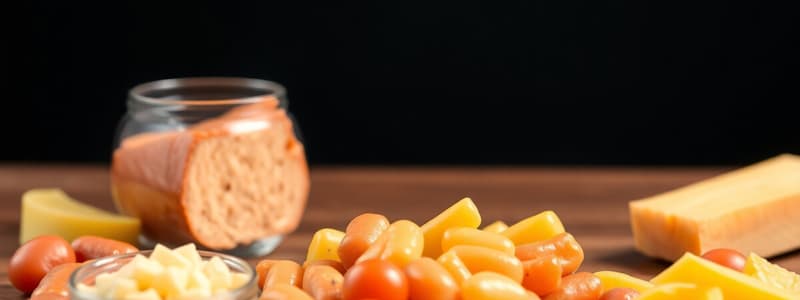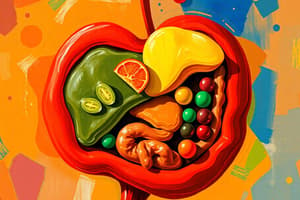Podcast
Questions and Answers
What activates the pancreatic zymogens in the small intestine?
What activates the pancreatic zymogens in the small intestine?
- Cholecystokinin (correct)
- Insulin
- Glucagon
- Gastrin
Which enzyme converts trypsinogen to trypsin?
Which enzyme converts trypsinogen to trypsin?
- Enteropeptidase (correct)
- Pepsin
- Carboxypeptidase
- Chymotrypsin
What is a common symptom of impaired pancreatic enzyme secretion?
What is a common symptom of impaired pancreatic enzyme secretion?
- Constipation
- Steatorrhea (correct)
- Diarrhea
- Nausea
Which transport mechanism is primarily used for the absorption of most free amino acids in the intestine?
Which transport mechanism is primarily used for the absorption of most free amino acids in the intestine?
What condition is a result of immune-mediated damage to the small intestine from gluten ingestion?
What condition is a result of immune-mediated damage to the small intestine from gluten ingestion?
How are di- and tripeptides absorbed by enterocytes?
How are di- and tripeptides absorbed by enterocytes?
What does cystinuria affect in terms of amino acid absorption?
What does cystinuria affect in terms of amino acid absorption?
What type of metabolism encompasses amino acid catabolism?
What type of metabolism encompasses amino acid catabolism?
What is produced when an alpha-keto acid loses its keto group and gains an amino group?
What is produced when an alpha-keto acid loses its keto group and gains an amino group?
Which enzyme is primarily responsible for transferring the amino group from alanine to alpha-ketoglutarate?
Which enzyme is primarily responsible for transferring the amino group from alanine to alpha-ketoglutarate?
Elevated levels of AST and ALT in plasma are primarily associated with which condition?
Elevated levels of AST and ALT in plasma are primarily associated with which condition?
What is generated from the oxidative deamination of amino acids?
What is generated from the oxidative deamination of amino acids?
Which amino acids do not participate in transamination?
Which amino acids do not participate in transamination?
What is the role of pyridoxal phosphate in the transamination reaction?
What is the role of pyridoxal phosphate in the transamination reaction?
What is the primary outcome of oxidative deamination conducted by glutamate dehydrogenase?
What is the primary outcome of oxidative deamination conducted by glutamate dehydrogenase?
Which aminotransferase is primarily associated with cardiac tissue?
Which aminotransferase is primarily associated with cardiac tissue?
What are amino acids primarily used for in the body?
What are amino acids primarily used for in the body?
Where does the digestion of proteins first begin?
Where does the digestion of proteins first begin?
What role does hydrochloric acid (HCl) play in protein digestion?
What role does hydrochloric acid (HCl) play in protein digestion?
Which enzyme is secreted as an inactive zymogen in the stomach?
Which enzyme is secreted as an inactive zymogen in the stomach?
What happens to excess amino acids in the body?
What happens to excess amino acids in the body?
What primarily drives the depletion of the amino acid pool?
What primarily drives the depletion of the amino acid pool?
Which organ is responsible for producing the majority of proteolytic enzymes for protein digestion?
Which organ is responsible for producing the majority of proteolytic enzymes for protein digestion?
What type of enzymes are involved in further cleaving polypeptides in the small intestine?
What type of enzymes are involved in further cleaving polypeptides in the small intestine?
What is the first phase of amino acid catabolism characterized by?
What is the first phase of amino acid catabolism characterized by?
How are nonessential amino acids typically created in the body?
How are nonessential amino acids typically created in the body?
What is one of the diagnostic importance of aminotransferase enzymes?
What is one of the diagnostic importance of aminotransferase enzymes?
What is the role of protein turnover in the body?
What is the role of protein turnover in the body?
What is formed when the alpha-amino group is transferred during transamination?
What is formed when the alpha-amino group is transferred during transamination?
Which product is primarily excreted as a result of amino acid catabolism?
Which product is primarily excreted as a result of amino acid catabolism?
What keeps amino acids safely locked away from oxidative breakdown?
What keeps amino acids safely locked away from oxidative breakdown?
Which option describes what happens to carbon skeletons of amino acids after metabolism?
Which option describes what happens to carbon skeletons of amino acids after metabolism?
Flashcards are hidden until you start studying
Study Notes
Amino Acids and Their Importance
- Amino acids are the building blocks of proteins and peptides, crucial for energy provision and the formation of hormones, neurotransmitters, and signaling molecules.
- Unlike fats and carbohydrates, amino acids cannot be stored in the body; they must be sourced from diet or synthesized.
Dietary Protein Digestion
- Proteins must be hydrolyzed into di- and tripeptides or individual amino acids to be absorbed by the intestines.
- Proteolytic enzymes from the stomach, pancreas, and small intestine are key to protein degradation.
Gastric Digestion
- Protein digestion initiates in the stomach with gastric juice, which includes hydrochloric acid (HCl) and pepsinogen.
- HCl denatures proteins and aids in the hydrolysis process, while pepsin, activated from pepsinogen by HCl, breaks down proteins into peptides.
Pancreatic Digestion
- In the small intestine, pancreatic proteases, activated by cholecystokinin and enteropeptidase, further cleave polypeptides into oligopeptides and amino acids.
- Trypsin serves as a key activator for other pancreatic zymogens.
Digestion Abnormalities
- Conditions like chronic pancreatitis or cystic fibrosis may impair protein digestion, leading to malabsorption and resulting in symptoms like steatorrhea.
- Celiac disease is characterized by immune-mediated damage to the small intestine, triggered by gluten ingestion.
Intestinal Absorption of Amino Acids
- Free amino acids are absorbed via sodium-dependent transport mechanisms.
- Di- and tripeptides are absorbed through a proton-linked transporter, PepT1, and then hydrolyzed to free amino acids before entering circulation.
Absorption Abnormalities
- Defects in amino acid transport systems in the intestines or kidneys can lead to conditions like cystinuria.
Catabolism of Amino Acids
- Amino acid catabolism involves nitrogen metabolism, where nitrogen enters the body as food and exits primarily as urea and ammonia.
- The amino acid pool is comprised of endogenous protein degradation, exogenous dietary protein intake, and synthesis of nonessential amino acids.
Protein Turnover
- Proteins are continuously synthesized and degraded, with a balance maintained to ensure stable protein levels.
- This turnover is vital for removing abnormal proteins and maintaining cellular function.
Nitrogen Removal and Transamination
- The α-amino group must be removed to facilitate amino acid energy metabolism.
- Transamination transfers an amino group from an amino acid to an α-keto acid, producing glutamate and α-keto acids, catalyzed by aminotransferases requiring pyridoxal phosphate.
Key Aminotransferases and Their Diagnostic Importance
- Alanine aminotransferase (ALT) and aspartate aminotransferase (AST) are significant enzymes located in the liver, heart, and kidneys.
- Elevated levels in plasma indicate cellular damage, useful for diagnosing liver diseases (high in hepatitis) and nonhepatic conditions like muscle damage.
Oxidative Deamination
- This process involves removing amino groups from amino acids, releasing ammonia, which is converted to urea in the liver.
- The resulting α-keto acids can enter central metabolic pathways, providing energy.
Studying That Suits You
Use AI to generate personalized quizzes and flashcards to suit your learning preferences.




